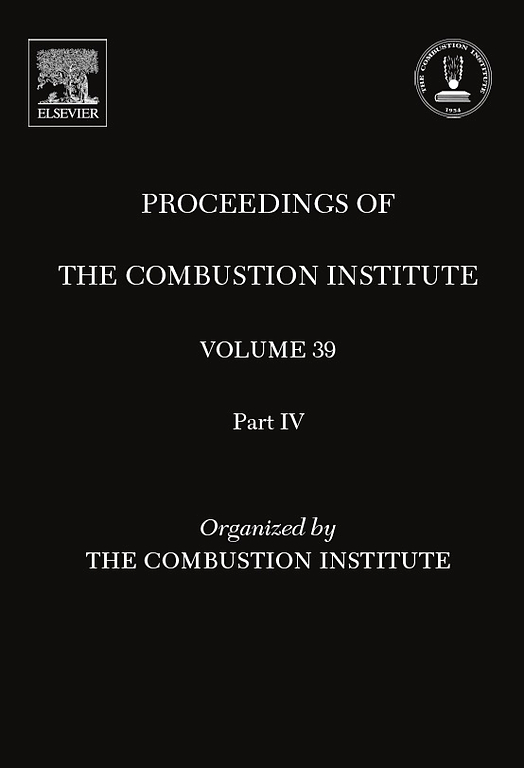利用双火焰预混合共燃概念减少氨燃烧中的氮氧化物[式略]排放
IF 5.3
2区 工程技术
Q2 ENERGY & FUELS
引用次数: 0
摘要
氨是一种可利用可再生能源生产的无碳燃料,具有替代化石燃料的潜力,对电力生产和推进行业的去碳化具有重大影响。然而,氨/空气混合物的高氮氧化物排放、窄可燃性和低火焰速度是其面临的挑战。本文研究了氨气和甲烷在双漩涡预混合燃烧器中进行双火焰预混合共燃(DFPC)的新概念,该概念可实现低氮氧化物排放和高火焰稳定性。利用详细的化学动力学机制和平面激光诱导荧光成像对 OH 和废气 NO 排放测量进行了大涡流模拟,以研究火焰/火焰相互作用和 NO 排放背后的基本机制。主要发现有(a) 使用 DFPC 概念可将氮氧化物排放量减少 90%,同时显著拓宽可燃性;(b) 甲烷/空气外焰可在两个火焰的剪切层中稳定氨气内焰;(c) 穿过剪切层泄漏的燃烧产物和过量氧气降低了内部氨/空气混合物的当量比,从而减少了接近均匀度的氨/空气火焰的氮氧化物形成,但增加了富燃料的氨/空气火焰的氮氧化物形成;(d) 内部和外部火焰的燃烧产物混合减少了烟道废气中的氮氧化物排放。本文章由计算机程序翻译,如有差异,请以英文原文为准。
Reduction of NO[formula omitted] emissions in ammonia combustion using a double-flame premixed co-combustion concept
Ammonia is a carbon-free fuel that can be produced from renewable energy sources and has the potential to replace fossil fuels, exerting a significant impact on the decarbonization of power production and propulsion industries. However, the challenge lies in the high NO emissions, narrow flammability, and low flame speed of ammonia/air mixtures. In this paper, we study a novel concept of double-flame premixed co-combustion (DFPC) of ammonia and methane in a double-swirl premixed combustion burner, which results in low NO emissions and high flame stabilization. Large eddy simulations using a detailed chemical kinetic mechanism and planar laser-induced fluorescence imaging of OH and exhaust gas NO emission measurements are employed to investigate the fundamental mechanisms behind flame/flame interactions and NO emissions. The main findings are: (a) NO emissions can be reduced by 90% using the DFPC concept along with a significant broadening of flammability; (b) the outer methane/air flame stabilizes the inner ammonia flame in the shear layer of the two flames; (c) combustion products and excess oxygen leaked across the shear layer decrease the equivalence ratio of the inner ammonia/air mixture, reducing the NO formation of close-to-stoichiometric ammonia/air flame but increasing the NO formation in the fuel-rich ammonia/air flames; (d) mixing of the combustion products from the inner and outer flames reduces the NO emissions in the flue exhaust gas.
求助全文
通过发布文献求助,成功后即可免费获取论文全文。
去求助
来源期刊

Proceedings of the Combustion Institute
工程技术-工程:化工
CiteScore
7.00
自引率
0.00%
发文量
420
审稿时长
3.0 months
期刊介绍:
The Proceedings of the Combustion Institute contains forefront contributions in fundamentals and applications of combustion science. For more than 50 years, the Combustion Institute has served as the peak international society for dissemination of scientific and technical research in the combustion field. In addition to author submissions, the Proceedings of the Combustion Institute includes the Institute''s prestigious invited strategic and topical reviews that represent indispensable resources for emergent research in the field. All papers are subjected to rigorous peer review.
Research papers and invited topical reviews; Reaction Kinetics; Soot, PAH, and other large molecules; Diagnostics; Laminar Flames; Turbulent Flames; Heterogeneous Combustion; Spray and Droplet Combustion; Detonations, Explosions & Supersonic Combustion; Fire Research; Stationary Combustion Systems; IC Engine and Gas Turbine Combustion; New Technology Concepts
The electronic version of Proceedings of the Combustion Institute contains supplemental material such as reaction mechanisms, illustrating movies, and other data.
 求助内容:
求助内容: 应助结果提醒方式:
应助结果提醒方式:


